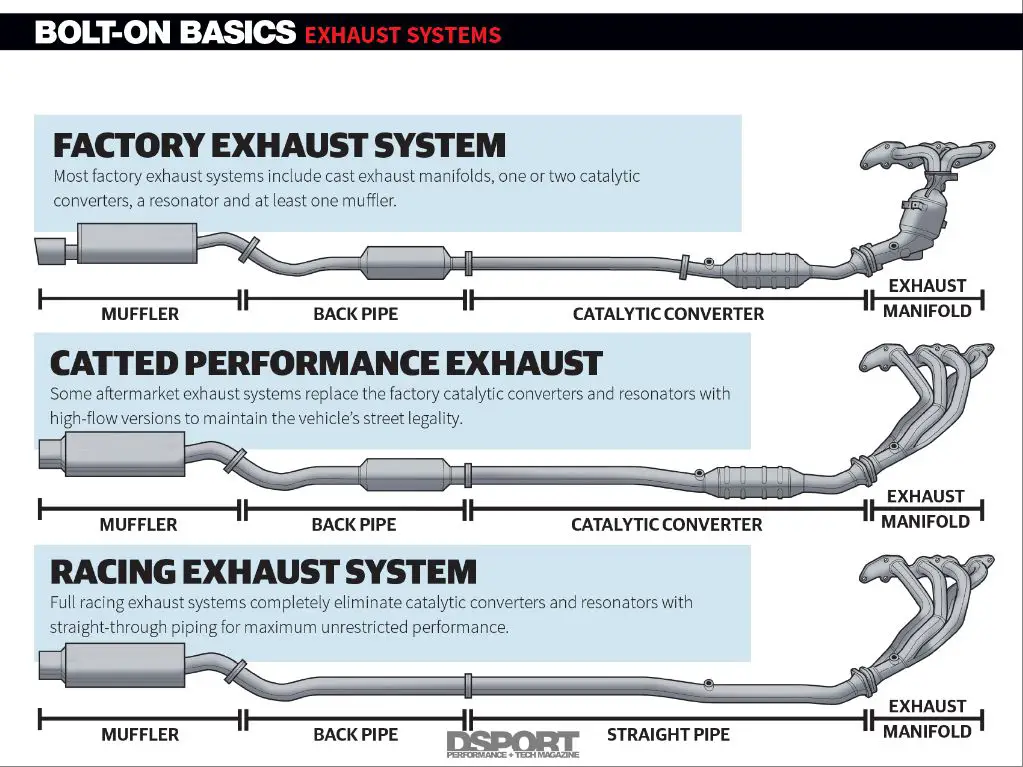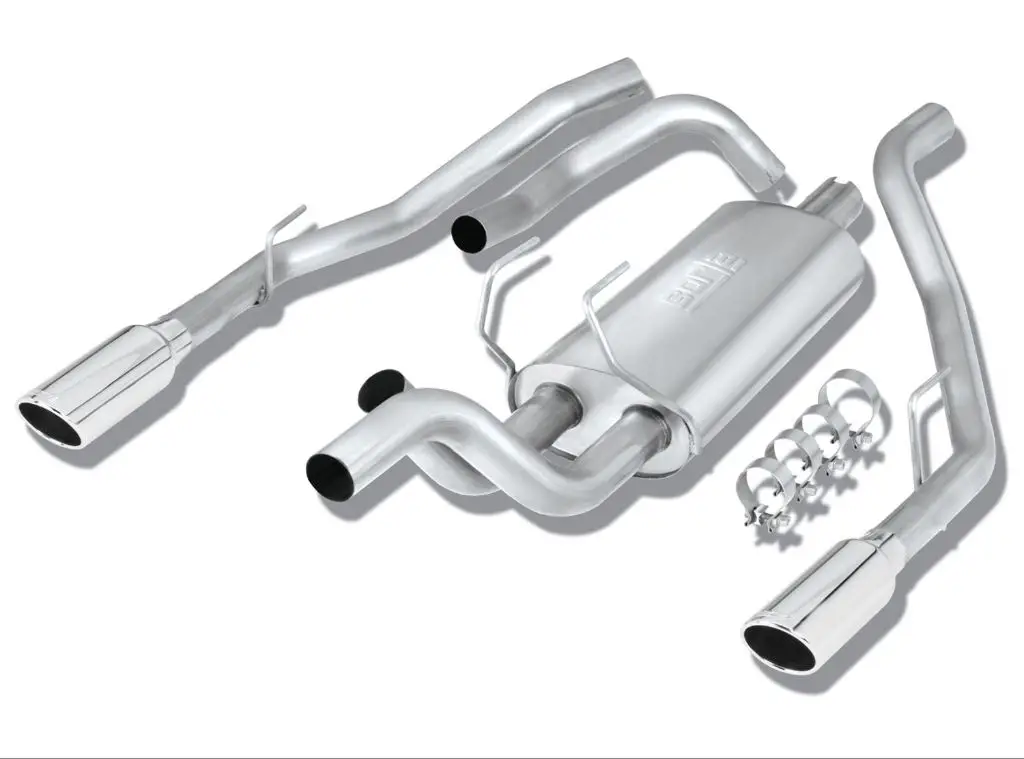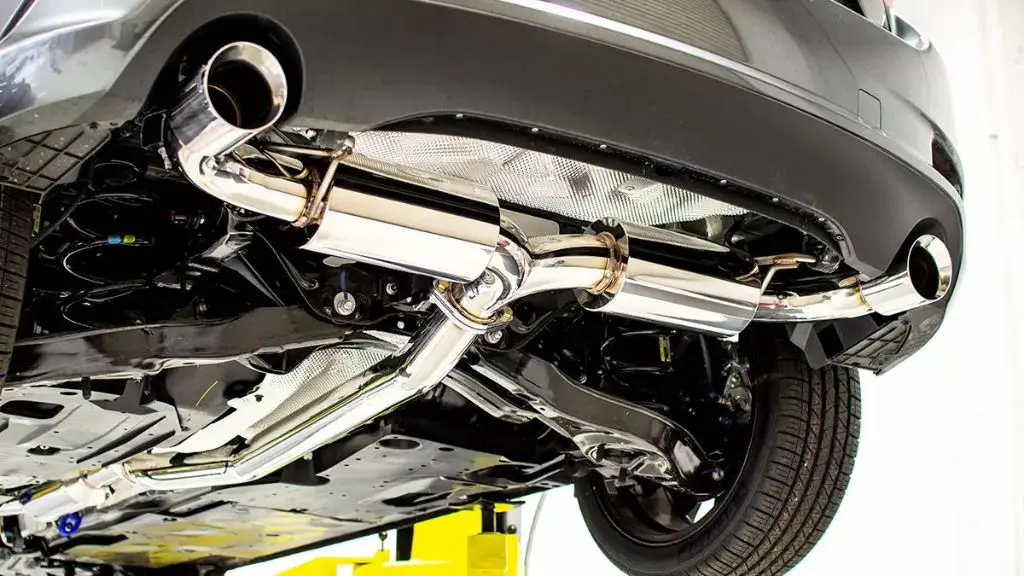What is a Cat Back Exhaust?
A cat-back exhaust system refers to the portion of the exhaust system from the outlet of the catalytic converter (also known as the cat) to the tailpipe. This includes the pipes, mufflers, and tips that make up the rear section of the exhaust system.
The main components of a cat-back exhaust system are:
- Pipes – These connect the outlet of the catalytic converter to the mufflers.
- Mufflers – Designed to reduce exhaust noise by dissipating sound waves.
- Tips – The visible exhaust pipes at the rear end of the vehicle where exhaust gas exits.
Cat-back exhausts differ from axle-back systems which only replace the pipes and mufflers post-axle. They also differ from turbo-back or full exhaust systems which replace everything from the turbocharger or engine manifold all the way back.
By only replacing the rear half of the stock exhaust, cat-back systems avoid modifying emissions equipment like the catalytic converter. This makes them legal in most jurisdictions. They provide many benefits over stock exhausts while avoiding the complex installation of full systems.
Do Cat Back Exhausts Add Horsepower?
Cat back exhausts can provide moderate horsepower gains by reducing restrictive airflow through the exhaust system. According to this Quora post, aftermarket exhausts can add anywhere from 2-3 horsepower to as much as 50 horsepower, depending on the vehicle and system chosen.
The horsepower gains from a cat back exhaust come from both less restrictive airflow, as well as scavenging effects. The smoother, less restrictive path allows the engine to expel exhaust gases faster, while the scavenging effect helps pull in more air by creating an area of low pressure. This improvement in airflow allows the engine to produce more power.
The exact horsepower increase will vary based on factors like the specific exhaust system design, engine size, vehicle model, and other modifications. In general, cat back exhausts are one of the easiest first modifications to unlock more horsepower from a stock vehicle exhaust. However, the gains are typically moderate compared to other more comprehensive mods.
How Cat Back Exhausts Increase Horsepower
Cat back exhausts can increase horsepower in a few key ways:

First, replacing the stock restrictive exhaust with a less restrictive cat back system improves engine efficiency. The stock exhaust creates backpressure which reduces performance. The smooth mandrel bent tubing and optimized mufflers in an aftermarket cat back allow more free flowing exhaust gases.
This improved exhaust flow leads to better scavenging effects, where the exiting exhaust gases help pull fresh intake charge into the cylinders (https://www.motordrive.com/how-exhaust-backpressure-affects-horsepower/). Reducing backpressure helps the engine breathe better.
The improved airflow also increases volumetric efficiency – the engine’s ability to fill the cylinders with air. More air means the ability to burn more fuel and generate more horsepower.
Overall, the optimized tubing diameters, smooth bends, and free flowing mufflers in a cat back exhaust system reduce restrictions and improve the engine’s ability to breathe, resulting in more power compared to stock.
Measuring the Horsepower Gains
The most accurate way to measure the horsepower gains from a cat back exhaust is by using a dynamometer or “dyno” for short. A dynamometer is essentially a set of rollers that a vehicle’s wheels sit on. The dyno then calculates horsepower and torque based on how much force is needed to turn the rollers at a given speed.
By running the vehicle on the dyno before and after the cat back exhaust installation, you can precisely measure the increase in rear wheel horsepower. This accounts for power losses through the drivetrain and gives a real world measurement. Dyno runs should be done on the same day in similar weather conditions for the most accurate comparison.1
You can also estimate potential gains based on the specific exhaust design. For example, a cat back system with minimal bends and smooth mandrel bent tubing may gain 10-15 hp. More restrictive designs may only add 5-10 hp. Larger diameter piping and less backpressure from high flow mufflers can also optimize gains.2
It’s important to note that the ECU may need to be tuned to take full advantage of the increased airflow. An optimized tune accounts for the change in backpressure and fueling needed for maximum horsepower gains.3
Other Benefits of Cat Back Exhausts
In addition to adding horsepower, cat back exhaust systems provide some other noteworthy benefits for your vehicle:
Better engine sound – By improving exhaust flow, cat back systems create a deeper, more aggressive exhaust note. This enhanced sound is often viewed as much more pleasing than a stock exhaust [1].
Weight reduction – Aftermarket exhausts are typically constructed from lightweight metals like aluminum or stainless steel. This cuts down on overall weight compared to heavy factory exhaust components [2].
Increased throttle response – Reduced backpressure improves throttle response, giving a more direct connection between pressing the gas pedal and power delivery.
Improved gas mileage – More freely flowing exhaust requires less effort for the engine, resulting in small MPG gains in some vehicles [1].
These advantages combine with added horsepower to make cat back exhausts a popular bolt-on mod for enthusiasts seeking performance, sound, and style improvements.
[1] https://www.sandgateautoelectrics.com.au/10-reasons-to-check-out-the-cat-back-exhaust-systems/
[2] https://www.magnaflow.com/blogs/magnaflow/cat-back-exhaust-vs-axle-back-exhaust-systems

Downsides of Cat Back Exhausts
While cat back exhausts can provide horsepower and performance gains, they also have some potential downsides to consider:
Increased Noise – Cat back exhausts are designed to optimize airflow and performance, which often results in an increase in volume and noise. This can be a benefit for drivers looking for a more aggressive exhaust note, but it may drone or be too loud for some motorists, especially on long drives.1
Potential Drone – Certain cat back exhausts are prone to droning, a sustained low frequency exhaust tone that can be annoying or fatiguing on long drives. Choosing an exhaust with varying pipe diameters and mufflers designed to minimize drone is recommended.1
Higher Costs – Quality cat back exhausts with mandrel bent piping and performance mufflers can be expensive, often costing over $500. While they may provide performance gains, the return on investment should be considered.1
Check Local Regulations – Increased noise levels may exceed local noise ordinances, especially when combined with other mods. Legality should be verified before installing a cat back exhaust.2
Best Practices for Installation
Properly installing a cat back exhaust system requires some mechanical skill and the right tools. Here are some best practices to follow:
Use a lift or jacks to gain access underneath the vehicle. Trying to install a cat back system without raising the vehicle makes the job far more difficult. Safely supporting the vehicle provides the access needed to loosen exhaust components and install the new system.
Replace old exhaust gaskets. The gaskets between exhaust components can become brittle and damaged over time. It’s important to replace old gaskets with new ones to prevent exhaust leaks. Use high temperature exhaust gaskets specifically designed for the application.
Follow torque specifications. The clamps and hardware that connect exhaust components need to be tightened to the proper torque levels. This prevents leaks and ensures the system won’t come loose. Consult the installation instructions for the proper torque specs.
Get an electronic tune. Installing a less restrictive cat back exhaust can impact fuel trim and air/fuel ratios. Getting an ECU tune optimized for the upgraded exhaust is highly recommended to get the most performance and maintain proper engine operation.
Citations:
How to Install a Cat-back Exhaust System
Popular Brands of Cat Back Exhausts

When shopping for a cat back exhaust system, there are several top brands to consider. Some of the most popular and well-respected include:
Magnaflow
Magnaflow (www.magnaflow.com) is known for manufacturing premium stainless steel exhaust components. Their cat back systems provide improvements in horsepower, torque, and the overall sound of the vehicle. They offer both affordable universal fit kits as well as high-end custom applications. Magnaflow exhausts produce a deep, powerful tone without being excessively loud or “raspy.”
Borla
Borla (www.borla.com) is one of the best-known brands in aftermarket performance exhausts. They are revered for their expert craftsmanship and quality materials like aerospace-grade stainless steel. Borla systems are pricier but deliver excellent gains in horsepower and torque across the power band. They produce a bold, race-inspired rumble. From their S-Type systems to customizable cat back kits, Borla is a top choice for many enthusiasts and tuners.
Flowmaster
Flowmaster (www.flowmastermufflers.com) specializes in chambered mufflers that provide maximum flow. Their Delta Flow technology is known for increasing power while maintaining a comfortable interior sound level. Flowmaster offers direct replacement kits for popular trucks and muscle cars. Their exhaust tone ranges from mild to aggressive, with the Flow FX line producing a deep mellow rumble.
In terms of pricing, Borla and Magnaflow systems range from $500-$1500. Flowmaster tends to be more affordable, with cat backs starting around $350. No matter which brand you choose, investing in a performance cat back exhaust is one of the most effective ways to enhance your vehicle’s horsepower, torque, and auditory experience.
Choosing the Right Cat Back Exhaust
When selecting a cat back exhaust system, there are several factors to consider:
Horsepower goals – Cat back exhausts can provide moderate horsepower gains, typically in the 5-15 hp range. If your main goal is adding significant horsepower, you may want to look at headers or turbo upgrades instead. For a modest bump, a cat back is a good option.
Sound preferences – The exhaust greatly impacts the sound of your vehicle. Think about the volume and tone you want. Some systems are designed to amplify certain frequencies for a deeper pitch. Brands like Flowmaster are known for their aggressive rumble.
Brand reputation and quality – Stick with reputable performance brands like Borla, Magnaflow, and Flowmaster that use higher grade materials. Poor quality exhausts can fracture and corrode over time. Read reviews and watch sound clips to gauge quality.
Price – Cat back exhausts range from a few hundred dollars for basic systems to over $1000 for premium brands. Set a budget and find the best system for your needs in that range.
Fitment – Ensure the system is designed specifically for your year, make and model vehicle. Customized fitment is crucial for proper installation and performance.
By balancing these factors, you can select the ideal cat back exhaust to achieve your goals whether that’s added horsepower, better sound, or increased performance and style.
Conclusion
In summary, cat back exhaust systems can provide moderate horsepower gains by reducing backpressure and allowing the engine to breathe and rev more freely. By replacing the stock exhaust piping with larger diameter piping, high-flow catalytic converters, and less restrictive mufflers, exhaust gases can exit more quickly and efficiently.

However, horsepower gains vary greatly based on the specific exhaust system and vehicle. While some systems may only add a couple horsepower, others can potentially add over 15 hp to the wheels. Gains are most noticeable in the mid to high RPM range.
Beyond just increasing power, cat back exhausts offer benefits like improved engine sound, increased fuel efficiency, and reduced weight. However, they also increase interior and exterior noise levels. Properly installing a cat back exhaust that meets local regulations is critical.
Overall, a cat back exhaust system is one of the simplest and most effective bolt-on modifications to add moderate power gains and an improved driving experience. But getting the most out of an exhaust requires carefully selecting the right brand and model for your specific vehicle.

